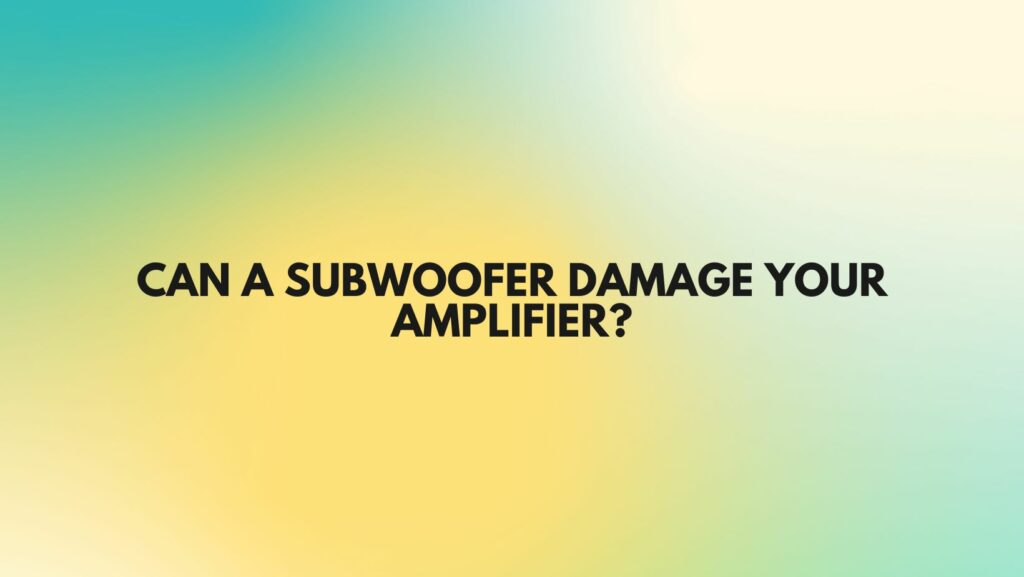Subwoofers and amplifiers are essential components of a high-quality audio system, especially when it comes to enhancing the bass performance in your audio setup. However, many audiophiles and casual users often wonder about the potential risks associated with connecting a subwoofer to an amplifier. Can a subwoofer damage your amplifier? In this article, we will delve into the relationship between subwoofers and amplifiers, exploring the risks, precautions, and common misconceptions surrounding this pairing.
Understanding the Basics
Before we delve into the potential risks and concerns, let’s start by understanding the basic components involved:
- Subwoofer: A subwoofer is a specialized speaker designed to reproduce low-frequency sound, commonly referred to as bass. It is responsible for providing depth and power to the audio, enhancing the overall listening experience.
- Amplifier: An amplifier is an electronic device that increases the amplitude of an audio signal. In the context of subwoofers, amplifiers are used to provide the necessary power for the subwoofer to produce deep bass tones with accuracy and precision.
The Role of Amplifiers in Subwoofer Systems
Subwoofers require more power to deliver low-frequency sounds effectively. Therefore, an amplifier is typically needed to ensure that the subwoofer can reproduce these frequencies with clarity and impact. Amplifiers come in various classes, each with its own set of specifications and power ratings, and they are usually matched with specific subwoofers to ensure optimal performance.
The Potential Risks
- Overpowering the Subwoofer: One of the most common concerns associated with connecting a subwoofer to an amplifier is overpowering the subwoofer. If the amplifier delivers too much power to the subwoofer, it can cause damage to the subwoofer’s voice coil, suspension system, or even the cone. This can result in distorted sound or, in extreme cases, a blown subwoofer.
- Underpowering the Subwoofer: Conversely, underpowering the subwoofer can also be problematic. When an amplifier cannot supply enough power to the subwoofer, it may attempt to push the subwoofer beyond its capabilities, causing distortion and potential damage to the subwoofer. Underpowering can lead to overheating of the amplifier, which, if left unchecked, can harm the amplifier’s components.
- Clipping and Distortion: Using an amplifier with insufficient headroom, or pushing it to its limits, can result in clipping and distortion. Clipping occurs when the amplifier tries to deliver more power than it is designed for, which can damage the amplifier and the subwoofer, affecting sound quality as well.
- Impedance Mismatch: Connecting subwoofers with the wrong impedance rating to an amplifier can cause problems. An impedance mismatch can lead to increased heat generation in the amplifier, potentially causing long-term damage. Therefore, it is crucial to ensure that the subwoofer and amplifier have compatible impedance ratings.
Precautions and Best Practices
To prevent damage to your amplifier when using a subwoofer, consider the following precautions and best practices:
- Match the Subwoofer and Amplifier: Always ensure that your subwoofer and amplifier are matched in terms of power handling and impedance. This helps prevent overpowering or underpowering issues.
- Use High-Quality Cables: Invest in high-quality, appropriately sized cables to connect your subwoofer to the amplifier. This reduces signal loss and interference, improving overall performance.
- Set the Gain Properly: Adjust the gain or volume control on your amplifier correctly. This ensures that you’re not pushing the amplifier into clipping territory.
- Install Proper Ventilation: Adequate ventilation is crucial for both the subwoofer and the amplifier. Ensure that they have sufficient airflow to dissipate heat effectively and prevent overheating.
- Use a Low-Pass Filter: Many amplifiers and subwoofers come with built-in low-pass filters. These filters help eliminate high-frequency noise that can cause distortion.
Conclusion
While the potential for subwoofers to damage amplifiers exists, it can be largely mitigated with proper precautions and responsible usage. Matching subwoofers and amplifiers, setting gain correctly, using high-quality cables, and providing proper ventilation are essential steps to ensure a harmonious relationship between these two vital components of your audio system.
In conclusion, a subwoofer can damage your amplifier if used improperly, but with the right knowledge and care, you can enjoy the full benefits of a subwoofer without harming your amplifier or compromising your listening experience. Remember that, in the world of audio equipment, knowledge and responsible use are your best allies.


